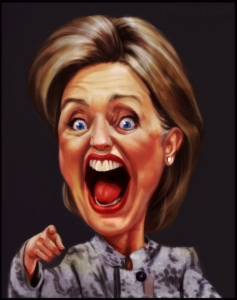 It just keeps getting worse for Clinton. Her self-made email scandal won’t go away, the Draft Biden movement is picking up steam and Democratic anxieties over her candidacy are continuing to grow. Now, there are signs her electoral coalition, once originally thought to be massive, is fracturing. Not only is she losing swing voters but elements of her base are souring on her candidacy.
It just keeps getting worse for Clinton. Her self-made email scandal won’t go away, the Draft Biden movement is picking up steam and Democratic anxieties over her candidacy are continuing to grow. Now, there are signs her electoral coalition, once originally thought to be massive, is fracturing. Not only is she losing swing voters but elements of her base are souring on her candidacy.
The latest Fox News poll finds that the Democratic primary is becoming less and less of a Clinton coronation. Nationally, Clinton leads the field with 51% followed by Sanders at 22%. Biden sits at 13%. This is Clinton’s lowest showing in any national poll and is indicative of just how far she has fallen if she is barely maintaining a majority of Democratic support. Also indicative of the GOP’s competitive primary a whopping 74% of Republicans say they are very interested in the 2016 election compared to 56% of Democrats.
A Monmouth poll of the Democratic primary backs up Fox’s findings. Only 52% of primary voters back her candidacy compared to 16% for Sanders and 13% for Joe Biden. But, if Clinton is not the nominee, a majority of Democratic voters are fine with Bernie. In other words, Hillary’s commanding lead in the polls is not due to her being better than her opponents but simply being better known.
If Clinton’s primary support has fallen her general election prospects are tanking. The coalition she needs to win is starting to fall apart. According to a new NBC/WSJ poll, “In June, 44% of white women had a favorable view of Mrs. Clinton, compared to 43% who didn’t. In July, those numbers moved in the wrong direction for Mrs. Clinton: Only 34% of white women saw her in a positive light, compared to 53% who had a negative impression of her.”
One of Clinton’s big selling points is her ability to bring white women back into the Democratic fold, especially suburban and college educated white women who favored Obama in 2012. But in this poll Clinton has seen these voters perceptions of her dip. Suburban women have an unfavorable view of Clinton as well as college educated white women. Both results indicate a steep drop from a month ago.
Even among the staunchest element of the party’s base, blacks, her image has been marred. In June, 81% African-Americans had a positive view of Clinton compared to 3% who did not. In July, those numbers had dropped to 66% favorable and 15% unfavorable. Further, blacks professed to having less enthusiasm to vote in 2016 relative to 2012. If Clinton cannot get women to swing to her she will need increased turnout among the party’s core constituencies.
Even if women come back to her there is a worrying sign a massive and important group of voters will not, Independents. Only 27% had a favorable view of Clinton compared to 52% who did not. These low water mark indicates just how much Clinton’s playing to the base on key issues (inequality, immigration, police brutality) has hurt her among these key swing voters.
Suburban and college educated women were crucial to Obama’s victories in Colorado, Virginia and Iowa in both 2008 and 2012. Incidentally, this is where polls have shown Clinton trailing Rubio, Walker and Bush. But these voters are also key for Democrats to maintain their edge in Ohio, Wisconsin and Minnesota as well as holding Pennsylvania and New Hampshire. If these numbers do not improve the GOP could improve enough in the Cincinnati or Philly suburbs to turn the older, more blue-collar states. Democrats in Florida have no margin for error whatsoever if fewer blacks turnout than in 2008.
Gallup finds much the same. Nationally, only 44% of all voters view Hillary favorably. This marks her lowest point ever and a drop of 22% from her high in 2012. Among Republicans, Independents and Democrats her numbers have tanked. In 2012, Hillary was viewed favorably by 41% of Republicans. Today it is 12%. In 2012 she was viewed favorably by 65% of Independents and 91% of Democrats. Today only 42% of Independents and 79% of Democrats view her favorably.
There is still time for the Clinton camp to turn around their fortunes. It is early in the contest. The Clinton camp just released their first ads of the cycle in New Hampshire and Iowa aimed at humanizing and reintroducing the candidate to voters. Unfortunately, these two states voters know Clinton well and probably have more hardened opinions of the former First Lady than voters in other states. Worse, a new Granite State/UNH poll finds Clinton narrowly leading Bernie Sanders 42%-36% in the first in the nation primary state.
There remains the possibility Republicans could help her out by nominating a fiery social conservative or Donald Trump. Even so, that takes Clinton’s political fortunes out of her own hands and into those of Lady Luck. Not a good position to be in for any candidate.

